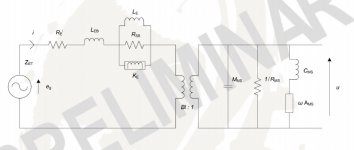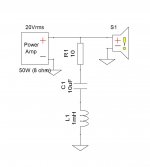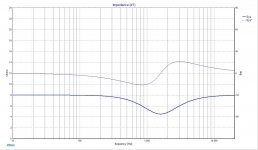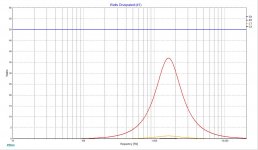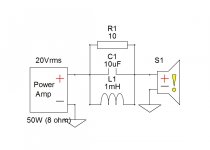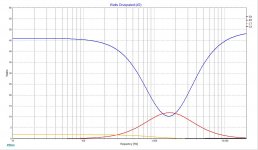My actual problem with those type of drivers with rising response topped with an out-of-band resonance peak, is that whatever you do to make the peak (s) to disappear (you can control the rising part with a cleverly designed XO including BSC elements), the energy presented by the peaks cannot simply disappear. It will be stored in the correction elements (RLC filters) and come back - where and when you want them the least.
At least this is what my experience tells me.
Out of axis listening and room response (reflection) corrected response is another story, that should be left to the listener to "fine tune" with those methods, (according to his/her tonal preference) the designer should aim for the most correct energy balance presuming on axis radation (which rarely equals the flattest amplitude response as we know)
At least this is what my experience tells me.
Out of axis listening and room response (reflection) corrected response is another story, that should be left to the listener to "fine tune" with those methods, (according to his/her tonal preference) the designer should aim for the most correct energy balance presuming on axis radation (which rarely equals the flattest amplitude response as we know)
Last edited:
My actual problem with those type of drivers with rising response topped with an out-of-band resonance peak, is that whatever you do to make the peak (s) to disappear (you can control the rising part with a cleverly designed XO including BSC elements), the energy presented by the peaks cannot simply disappear. It will be stored in the correction elements (RLC filters) and come back - where and when you want them the least.
At least this is what my experience tells me.
Out of axis listening and room response (reflection) corrected response is another story, that should be left to the listener to "fine tune" with those methods, (according to his/her tonal preference) the designer should aim for the most correct energy balance presuming on axis radation (which rarely equals the flattest amplitude response as we know)
I just ignore on axis response, but not all drivers are that forgiving, so that i also ignore the not forgiving drivers, whatever their other qualities might be.
Trouble with mid woofers is that if they have big bass muscle enough, the rest of the response is crap but forgiven for the sake of devotion to bass (mediocrity), and that's not a fair trade nor good business to my interests...😡
SS 8545 SS 8535 and the that Proac ******** cloned floorstander really sucks, it's high time people know about those atrocities!😀
Last edited:
And one more thing in the defense of SB Acoustics: There is nothing wrong here with SS DNA...
I've tried a good dozen of their drivers already, and found that -with very few exceptions- they are very carefully and cleverly designed versatile products, with very useful parameters and "user friendly" response patterns.
Also their product consistency, customer support and pricing makes them one of the best driver manufacturer of these days IMHO.
I've tried a good dozen of their drivers already, and found that -with very few exceptions- they are very carefully and cleverly designed versatile products, with very useful parameters and "user friendly" response patterns.
Also their product consistency, customer support and pricing makes them one of the best driver manufacturer of these days IMHO.
And one more thing in the defense of SB Acoustics: There is nothing wrong here with SS DNA... .
Just conflincting interests...😀 No problem, this won't make of me a pro audio 20ºX40º junkyard addict, am still a son of this doggy master's voice...😀
Last edited:
the energy presented by the peaks cannot simply disappear. It will be stored in the correction elements (RLC filters) and come back - where and when you want them the least.
At least this is what my experience tells me.
Isn't it converted to heat?
I just ignore on axis response, but not all drivers are that forgiving, so that i also ignore the not forgiving drivers, whatever their other qualities might be.
Trouble with mid woofers is that if they have big bass muscle enough, the rest of the response is crap but forgiven for the sake of devotion to bass (mediocrity), and that's not a fair trade nor good business to my interests...😡
SS 8545 SS 8535 and the that Proac ******** cloned floorstander really sucks, it's high time people know about those atrocities!😀
I respect your personal view, likes, dislikes, but unfortunately a designer must see things through a different glass -unles he wants to design a product for a very narrow target group. Which is rather unfortunately a tendency in these days, that's why there are so many "atrocities" exist on the speaker front.
I can easily design a speaker that I prefer for myself, but try to do that for a wider audience, and things become complicated rather quickly... Compromises, sacrifices all along the way, not an easy ride, believe me.
Isn't it converted to heat?
Part of it yes -on the resistive element- but the rest is not. It is like a spring: push it, becomes shorter, stores energy, but when you stop pushing it kicks back, releasing the stored energy where it can.
Rough analogy, but expressive I think. Both coils and capacitors store and release energy in a similar manner.
Last edited:
I can easily design a speaker that I prefer for myself, but try to do that for a wider audience, and things become complicated rather quickly.
I hate the idea of pleasing an audience, target people, rather prefer the made to measure, one to one business. Mainstream and happy fews niches suck so much to me..

Part of it yes -on the resistive element- but the rest is not. It is like a spring: push it, becomes shorter, stores energy, but when you stop pushing it kicks back, releasing the stored energy where it can.
Rough analogy, but expressive I think. Both coils and capacitors store and release energy in a similar manner.
Can you give an example of how this energy is released and what relative frequency band does it affect? Is it measurable? Does active equalisation give better results in this case ?
So help me out folks. Where does the Elipticor place among the Scanspeak line in terms of pricing and stuff? Is it along the lines of the Revelator? Or does it surpass the Illuminator, in hype, and perhaps function? Just want to guage the priceyness. 🙂
So help me out folks. Where does the Elipticor place among the Scanspeak line in terms of pricing and stuff? Is it along the lines of the Revelator? Or does it surpass the Illuminator, in hype, and perhaps function? Just want to guage the priceyness. 🙂
They will be easily on top of the food chain - at least regarding the price. About the rest - well, that's debatable.
Ach so? Loudspeaker gestalt? What's wrong with the elipsoid gestalt zo...?🙄
That got nothing to do with the elipsoid VC, that's a matter of the membrane geometry and material. But if you change the shape/geometry of the membrane to gain some (possible?) advantages, you will have to bear with the consequences too.
So does this mean ScanSpeak is going away from the cut paper / multi-layer cone approach??
Noooooooooooo!!!! << whimpers from under the bed >>
Noooooooooooo!!!! << whimpers from under the bed >>
Part of it yes -on the resistive element- but the rest is not. It is like a spring: push it, becomes shorter, stores energy, but when you stop pushing it kicks back, releasing the stored energy where it can.
Rough analogy, but expressive I think.
Haha, no. Great imagination but maybe a bit too much ignorance.
A spring stores energy, that's correct. But it keeps the energy as long as it's confined from expanding again to the resting shape, so it's constantly trying to return to the former shape and keeping up the force, not only 'kicking back' if you stop pushing.
That would be the analogy of a capacitor. But only at DC. The music signal isn't DC though. It's constantly changing (AC) and that introduces the element of time. Time and change of voltage go hand-in-hand and the crossover elements do not 'release' it 'when they want'. And they aren't suddenly disconnected and reconnected to chose the worst timing to 'release' the energy. No, they change constantly the phase, depending on the frequency, that's why a crossover works. And that's how a speaker works, too. Look at this diagram from the ScanSpeak datasheet:
That's a diagram of a speaker, divided into the separate equivalent electric acting elements. (Well, to be exact, the voltage source isn't really part of the speaker, blame SS for it.)
Both coils and capacitors store and release energy in a similar manner.
Uhm, no. They work completely different. While you can compare a capacitor on DC with the spring, a coil is always only storing energy over a very limited time, after that it's gone. The equivalent of a coil would be, you press the 'spring' together, wait a moment and release it then it stays the way how you pressed it together. So to DC, a coil is just a resistance. It only works on change of voltage respective current.
This is meant in the most possible positive way: If you want to know what's happening and understand what's advertising crap and what's actually important, please try shed the half knowledge and learn the founding physics. There are loads of learning material out there, pages, videos, measurements, experiments.
Attachments
Well then,-being totally ignorant- I will start to study the related topics, maybe finally I can learn how a speaker works. However your approach is rather academic and based on -otherwise well established- strongly simplified theory, but the minor problem is, that the operation, and the interactions between real world (i.e. less than perfect) loudspeakes, crossover elements and sources (amplifiers) creates a much more difficult situation than your cited example. Even the theoretical model of a real world speaker -including ALL os its mechanical elements and their resonant interactions- would be a few times more complex than the drawing you showed. During the reproduction of actual musical signals the real time energy relations between electrical and mechanical parts of a speaker -not to mention the crossover elements feeding them- change rapidly, and cannot be described with such simple models. If that would be case we could listen only to very good and excellent speakers.
The energy stored in any type of (mechanical or electrical) resonant circuit will be dissipated -over a certain time- on the path that shows the least resistance. I know this is also an oversimplified statemnt, but true.
Believe me when I started this as a hobby I did my (plenty of) readings, just to get confused over the time finding out that those models are great for educational purposes, but worth very little in practical work. If everything worked according to those models, then we wouldn't actually chat about rising responses, out of band resonances, and shitty speakers made by respected manufacturers
Life is a bit more than easy application of collected studies and theories.
The energy stored in any type of (mechanical or electrical) resonant circuit will be dissipated -over a certain time- on the path that shows the least resistance. I know this is also an oversimplified statemnt, but true.
Believe me when I started this as a hobby I did my (plenty of) readings, just to get confused over the time finding out that those models are great for educational purposes, but worth very little in practical work. If everything worked according to those models, then we wouldn't actually chat about rising responses, out of band resonances, and shitty speakers made by respected manufacturers
Life is a bit more than easy application of collected studies and theories.
Last edited:
As Frangus asked before - can that energy storage be measured or observed in any way with xover in place ?
My actual problem with those type of drivers with rising response topped with an out-of-band resonance peak, is that whatever you do to make the peak (s) to disappear (you can control the rising part with a cleverly designed XO including BSC elements), the energy presented by the peaks cannot simply disappear. It will be stored in the correction elements (RLC filters) and come back - where and when you want them the least...
Last edited:
But then-on the other hand- I should be proud of myself, because I've designed and built around a hundred (or so) not too bad speakers in my life -some of them commercially succesful- without really knowing what I am doing. Not bad, I guess 😎
There is a reason why simulation tools exist so we don't guess and oversimplify things and make us look uneducated at the same time.
S1 line would be an 8 ohm resistive speaker, other curves are self explanatory.
S1 line would be an 8 ohm resistive speaker, other curves are self explanatory.
Attachments
Last edited:
As Frangus asked before - can that energy storage be measured or observed in any way with xover in place ?
Well, I haven't tried to do such measurements yet, but I guess it can be done by feeding the X-over-speaker complex with the resonant frequeny of the RLC circuit, and observe (record) the waveform at the speaker terminals with a suitable device (storage scope for example). But then again this will show you (if it will show anything at all) only the static behaviour of the circuit at that frequency, with complex signals -such as music- I have no idea how it could be done.
One thing I know for certain -based on countless listening tests- that the inclusion of such a circuit in te XO somehow robs the life, the essence of the music, my finding was the lack of attack and fine detail. It is likely that the sudden sharp changes in phase and impedance response what are responsible for this, but I cannot really explain it any further.
- Home
- Loudspeakers
- Multi-Way
- Scan-Speak has a new line: The Ellipticor
